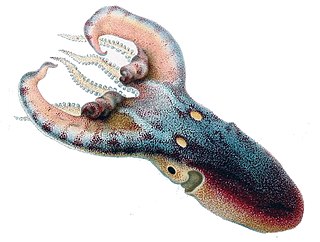 W
WThe Atlantic pygmy octopus, also known as the small-egg Caribbean pygmy octopus, is a small octopus species in the order Octopoda. Fully grown, this cephalopod reaches a mantle length of 4.5 centimetres (1.8 in) with arms up to 9 centimetres (3.5 in) long. They are known for being intelligent creatures with keen senses, particularly good sight.
 W
WThe California two-spot octopus, often simply called a "bimac", is an octopus species native to many parts of the Pacific Ocean including the coast of California. One can identify the species by the circular blue eyespots on each side of its head. Bimacs usually live to be about two years old. They are closely related to Verrill's two-spot octopus. In 2015, the genome was sequenced.
 W
WThe common blanket octopus or violet blanket octopus is a large octopus of the family Tremoctopodidae found worldwide in the epipelagic zone of warm seas. The degree of sexual dimorphism in this species is very high, with females growing to two meters in length, whereas males, the first live specimen of which was seen off the Great Barrier Reef in 2002, grow to about 2.4 cm. Individual weights of males and females differ by a factor of about 10,000.
 W
WThe Humboldt squid, also known as jumbo squid, jumbo flying squid, pota, or diablo rojo , is a large, predatory squid living in the waters of the Humboldt Current in the eastern Pacific Ocean. It is the only species of the genus Dosidicus of the subfamily Ommastrephinae, family Ommastrephidae.
 W
WIllex coindetii, commonly known as the southern shortfin squid or broadtail shortfin squid, is a species of neritic squids in the family Ommastrephidae. They are found in the Mediterranean Sea and on both sides of the north Atlantic Ocean.
 W
WIllex illecebrosus, commonly known as the northern shortfin squid, is a species of neritic squids in the family Ommastrephidae. They are found in the northwest Atlantic Ocean, from off the coast of eastern North America to Greenland, Iceland, and west of Ireland and the United Kingdom. They are a highly migratory and short-lived species, with lifespans of less than a year. They are commercially important and are fished extensively, mostly for the Canadian and Japanese markets. Northern shortfin squid is a migratory species of squid with a distribution ranging from Florida Straits to Newfoundland in the Northwest Atlantic Ocean. The species is native to Canada, Greenland, Iceland and United States. The species has an average lifespan between 1–1.5 years in which most live less than a year. The location of the fishery of the squid is mainly in Mid-Atlantic Bight from between summer and fall.
 W
WIllex oxygonius, commonly known as the sharptail shortfin squid, is a species of neritic squids in the family Ommastrephidae. Of the species of the genus Illex, they have the most restricted range, being found only in the western North Atlantic Ocean; from off New Jersey, south to the Straits of Florida and into the Gulf of Mexico. They are very difficult to distinguish from Illex coindetii and Illex illecebrosus, with which their geographic range overlaps. The most obvious difference of I. oxygnius is their sharper fin angles of 25° to 40°. There is also the possibility that they may be a hybrid of I. coindetii and I. illecebrosus.
 W
WThe larger Pacific striped octopus (LPSO) is a species of octopus known for its intelligence and gregarious nature. The species was first documented in the 1970s and, being fairly new to scientific observation, has yet to be scientifically described. Because of this, LPSO has no official scientific name. Unlike other octopus species which are normally solitary, the LPSO has been reported as forming groups of up to 40 individuals. While most octopuses are cannibalistic and have to exercise extreme caution while mating, these octopuses mate with their ventral sides touching, pressing their beaks and suckers together in an intimate embrace. The LPSO has presented many behaviors that differ from most species of octopus, including intimate mating behaviors, formation of social communities, unusual hunting behavior, and the ability to reproduce multiple times throughout their life. The LPSO has been found to favor the tropical waters of the Eastern Pacific.
 W
WMagnapinna pacifica is a species of bigfin squid known only from three immature specimens; two caught at a depth of less than 300 m and one from a fish stomach. M. pacifica is the type species of the genus Magnapinna. It is characterised primarily by its proximal tentacles, which are wider than adjacent arms and bear numerous suckers.
 W
WMastigoteuthis agassizii is a species of whip-lash squid. It is the type species of the genus.
 W
WThe neon flying squid, sometimes called the red flying squid, akaika, and red squid is a species of large flying squid in the family Ommastrephidae. They are found in subtropical and temperate oceanic waters globally.